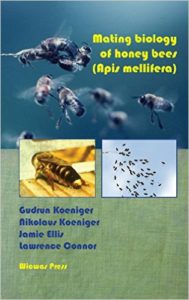Mating biology of honey bees (Apis mellifera), by Gudrun Koeniger and Nikolaus Koeniger with Jamie Ellis and Lawrence Connor
Wicwas Press
1 edition (December 22, 2014) Hardcover: 155 pages.
 Review by Robert Burns
Review by Robert Burns
I just finished reading the book on honey bee mating biology. Wow! Although sex is usually a ‘hot’ topic, I can really appreciate the research and science that has gone into this work. The book has some excellent photographs and charts and diagrams. There’s lots of great science here that explains the bee mating biology in simple terms.
I don’t believe I have read any other book that is a better culmination of the works on the mating happenstances of our wonderfully under-appreciated honey bees. I have my other queen books Bee Sex and Queen Rearing and other guides. However, there hasn’t been quite any other that is more descriptive, especially of the 3rd caste –Drones. The male bees seem to never get enough attention and respect.
Of course, there’s lots of talk about bee sex: polyandry, maturation of drones, maturation of queens, congregation areas where drones and queens meet for mating, sperm storage in the queen as well as mixing and transfer, testes and sperm development in drones, weather, and fortunate timing.
Apparently, the mating of honey bees is mostly getting lucky! Therefore, queens try to fly far away. Drones try to stick closer to home. For success, a queen and drones from the same colony need to try to avoid the possibility of incest. Weather has to cooperate, too. This book explains how far away and where the drones and queens fly, when they fly, and how they do the deed.
I thoroughly enjoyed the explanation of “material transfers in space” making the comparison the drones and a queen to space shuttles and a space ship. It all comes down to why the queen and drones must leave the hive to find each other and mate.
I also much appreciated the larger font size that made it easier on the eyes. Nearly all of the photos were done by the Koenigers, the husband and wife biologist team from northern Germany. There are plenty of graphs and charts and labeled diagrams.
I also enjoyed reading and learning again about drone congregation areas (DCA’s). A DCA is a concept of an aerial location marked by geographical features where drones like to gather to fly, do acrobats, and hang out in the air looking for a queen.
Our NEKBA member and supporter, Chip Taylor, is cited several times for his studies in this book, as are many other biologist and beekeeper scientists. On a side note, I was at one of the open-house bee events in the late 80’s when NEKBA supporter and member Chip Taylor had hosted on the KU campus.
There is a fair amount of information that you’ll get from the book on honey bee genetics. The book could probably use an entire chapter on the subject. I had taken it upon myself earlier this year to learn more about bee genetics, so it’s more of a personal interest that I’d like to see more information about the subject. I made a presentation of it just in case. However, genetics is well presented in relation to mating biology in the book, and there were some interesting updated facts that I came across.
There are lots of good facts in this book like that drones fly to nearby areas and queens like to fly far away, also, that a queen takes in more sperm than she will actually retain, using less than 10% of what is possible. You’ll need to read the book for more facts.
I don’t think you’ll find another book quite like this one for your personal library. It’s sure to have an impact on your beekeeping practices and understanding of what is happening in your be yard from April to October-when we have drones with us.
Look for this informative book and others in the association library. You can also order directly http://www.wicwas.com This will surely be another one of those books that will add to your marvelation about your honey bees, and enlighten you about some of the shenanigans happening in the natural world around you -emanating from your bee yard!

